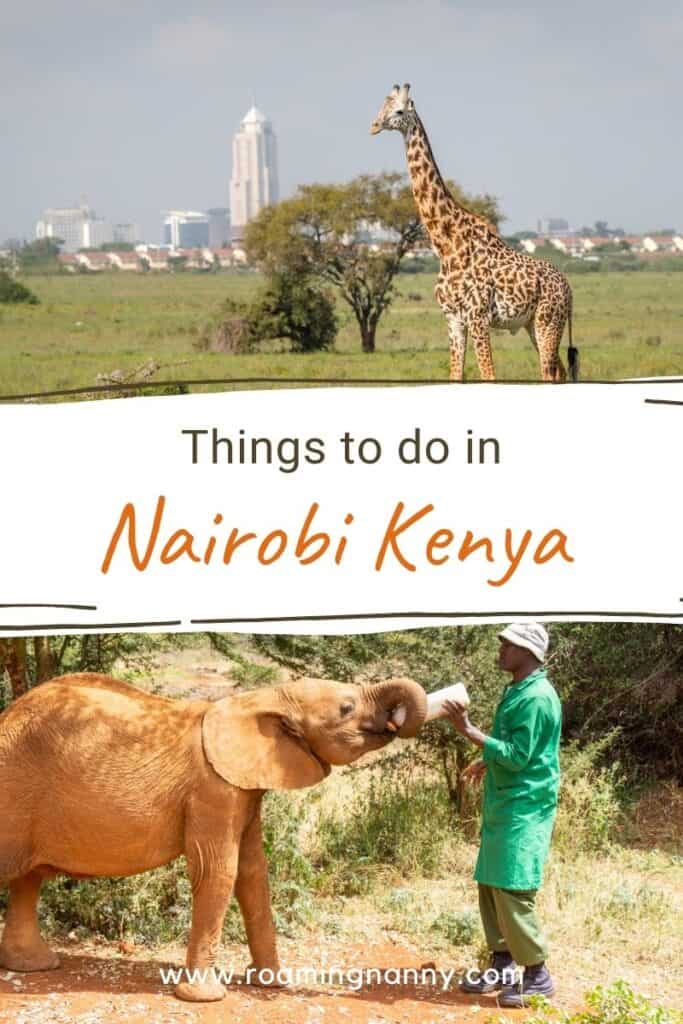Nairobi, Kenya doesn’t have the best reputation. It’s more famous for its street crime than for being a holiday destination. But the reality is Nairobi is a pretty great city. There are tons of fun things to do in Nairobi — whether you like wildlife or history, shopping or eating.
You need at least two days in Nairobi to see the city’s top attractions, shop at the Maasai markets and enjoy the world-class dining scene. In this post, I’ll tell you all about the best activities to include in your Nairobi itinerary. Let’s get started!
Fun Things to do in Nairobi Kenya
Where to stay in Nairobi Kenya
Luxury Lodging in Nairobi
One of the best high-end and beautiful hotels in Nairobi is Hemingways Nairobi. The hotel’s bright airy rooms will serve as your oasis from the busy city of Nairobi. If you need more relaxation head to the Serenity Spa and indulge in one of their many treatments.
Mid-Range Lodging in Nairobi
After I completed my Keynan safari (in the Masai Mara and Ol Pejeta) I spent 2 extremely relaxing nights at the Tamarind Tree Hotel.
Our first day we tumbled into bed in the evening after a long day of games drives and flights from the Masai Mara back to Nairobi. The Tamarind Tree Hotel is located close to Wilson Airport, which is the smaller airport in the city where the airline SafariLink operates most of its flights out of.
The second day we lounged by the pool sipping drinks and eating snacks from the on-site restaurant. We had plans of going out to see the city but were so tired and the hotel was relaxing and chill we didn’t do a single thing.
Budget Lodging in Nairobi
Wildebeest Eco Camp was my home base in Nairobi before I headed out on my Safari in Nairobi National Park. My friend Kate and I stayed in one of the safari tents in the Garden. Each tent has lights, beds with linens, and is completely enclosed to keep mosquitos out. For travelers on even more of a budget, there are beds in a dormitory. Both the safari tents and the dorms have shared bathrooms and showers.
Keep scrolling to read more about Wildebeest Eco Camp.
Visit the “Elephant Orphanage”- the most heartwarming Nairobi activity
Of all the fun things to do in Nairobi, Kenya, this one easily tops the list. If you love baby elephants (and who doesn’t!?), you can’t miss Nairobi’s “elephant orphanage.”
The orphanage’s official name is the David Sheldrick Wildlife Trust. Sheldrick’s family established the facility as a way to help Kenya’s elephant population in Tsvaro East and Tsvaro West Parks recover after decades of poaching and game hunting.
The orphanage takes in baby elephants whose mothers have died, or who have been caught in traps, or who have somehow been separated from their herds. The baby elephants roam free in Nairobi National Park during the day and only come to the center for feedings. They bond naturally with the wild elephants in the herd, and have extremely limited encounters with humans. Over the last 40+ years, the Trust has a 100% success rate of reintroducing these elephants back into the wild, where they integrate with new herds in parks across Kenya.

Visitor Details
Visitors can observe the daily feeding sessions at 11 am. You’ll stand around the outside of a large mud pit and watch the babies come to play and feed. A guide describes the elephants — you’ll feel like you know each of them personally by the end of the hour — and talks about the threats they face in the wild on a daily basis.
The elephants do occasionally decide to interact with people. But there is absolutely no attempt to get them to — some of them just happen to be curious sometimes. (I got a headbutt when I visited.) Even if the elephants don’t come near you, they might spray you with mud!
The project is widely considered one of the most ethical and effective encounters you can have with elephants anywhere in the world. Do not miss it when you visit Nairobi.
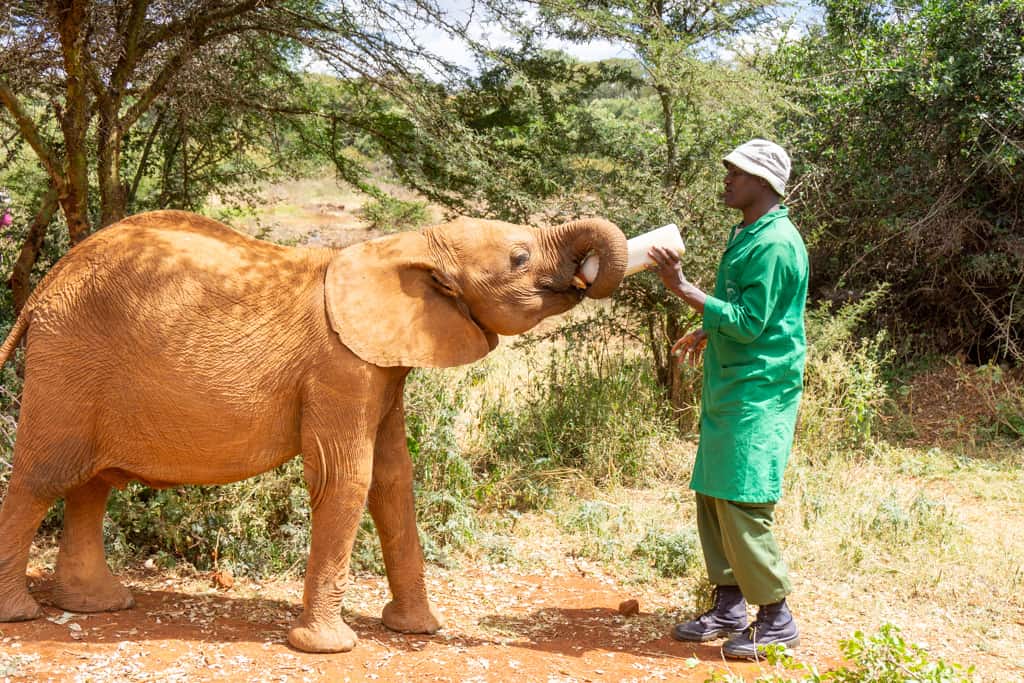
Practical information for visiting the David Sheldrick Wildlife Trust
Price: 500 shillings per person upon publishing of this post
Opening hours: The center only opens at 11 am daily. You should be in line by 10:45 to get a good spot.
Facilities: The center has clean restrooms. You’ll stand outside in the open while you watch the elephants, so bring sunscreen, sunglasses, a hat, and a rain jacket.
Location: The center is on the far outskirts of Nairobi National Park, bordering on the suburbs of Karen and Langata.
How to get there: The easiest ways to reach the center are on a tour or in an Uber or taxi. But you can get here on public transport. Take any bus or matatu from the CBD heading to Karen/Langata and hop off at Bomas. Then, grab another matatu going south on Magadi Road and ask to be dropped off at the elephant orphanage. It’s a half-kilometer walk from the matatu stop. Note that you’ll be walking through the park, which has lions and elephants — stick to the main road here. You’ll likely see some wildlife along the way (I saw elands and ostriches).
Pin it for Later!

Hang out with giraffes at the Nairobi Giraffe Center – one of the most fun things to do in Nairobi
If baby elephants weren’t enough for you, the next thing on the list of what to do in Nairobi is the Giraffe Center. Here, you can see conservation in action to protect the highly endangered Rothschild’s Giraffe. Plus you get to feed the giraffes and take all sorts of Instagrammable photos.
Rothschild’s Giraffes are a subspecies of giraffe that inhabit the plains of Kenya and Uganda. They have distinctive white markings on their legs, with no spots below the knee (they look like they’re wearing stockings). Fewer than 2,000 of these giraffes live in the wild today. The Nairobi Giraffe Center operates a conservation, breeding and reintroduction program to help them recover. By visiting you’ll be doing good and enjoying one of the most fun things to do in Nairobi.
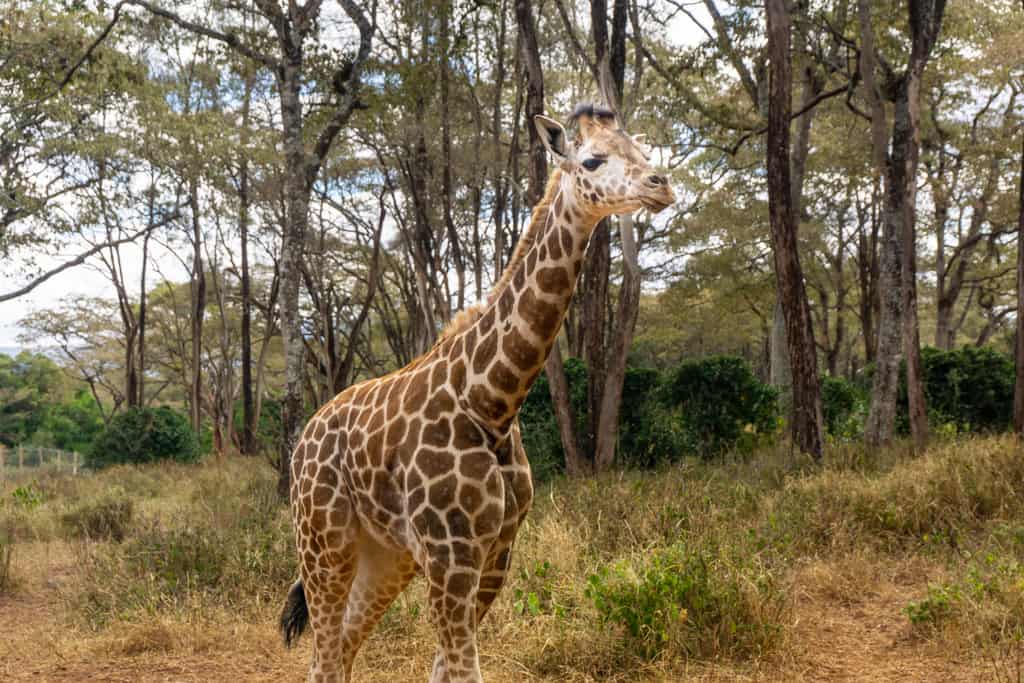
For the price of admission, you get a little baggie of food that you can use to lure friendly giraffes over to a handful of platforms. They aren’t shy at all — they won’t hesitate to rest their heads on your shoulders, or lick you, or give you a kiss (if you’re so inclined). The center even has a couple babies who might come say hi if you’re lucky.
Additionally, the site has a museum where you can learn about the history of Rothschild’s Giraffes in Kenya. This takes about 30 minutes to walk through and is a great educational addition to one of the most fun things to do in Nairobi.
The Nairobi Giraffe Center also shares a property with Giraffe Manor, which you’ve probably seen on Instagram. But unless you’re willing to shell out nearly a thousand bucks (! yes, really !) to stay there overnight, you won’t be able to visit.
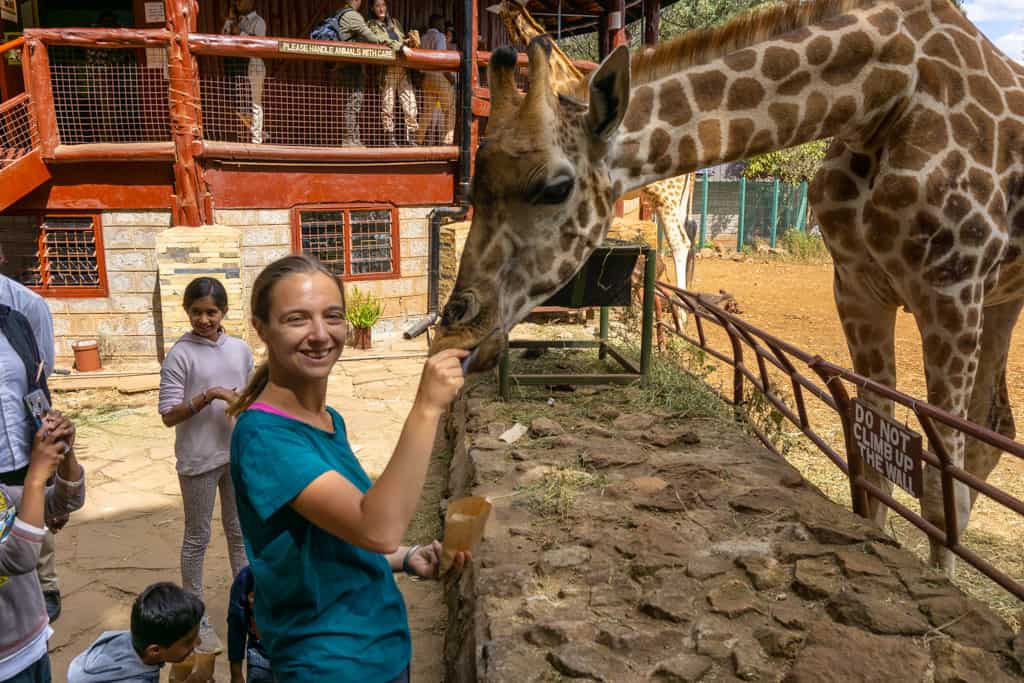
Practical information for visiting the Nairobi Giraffe Center
Price: 1,500 shillings per person. You can only pay by credit card or Mpesa (mobile money).
Opening hours: 9 am – 5 pm. Aim to visit around 4 pm for fewer crowds and more active giraffes.
Facilities: The Giraffe Center has restrooms, a gift shop, and a cafe.
Location: The Giraffe Center is in Karen.
How to get there: The easiest ways to reach the center are on a tour or in an Uber, taxi or motorcycle taxi. On public transport, hop on a bus going south at the Langata Junction (where Langata Road meets South Langata Road shortly after Galeria Mall) and hop off at the law school. It’s a 20-minute, well-signed walk in a very safe area from here. Even though they look close on the map, no public transport runs from the elephant orphanage to the Giraffe Center — you’ll need to backtrack through Langata. You can also just walk from Bomas, which takes about an hour and is safe in daylight.
See the dance performance and learn about village life at Bomas of Kenya: fun things to do in Nairobi
Kenya is the most culturally intriguing country in East Africa. On one hand, it’s the only country in the region that has a genuine, healthy middle class. On the other, tradition runs deep here and you’ll encounter folks in tribal communities whose ways of life have barely changed in 1,000 years.
Bomas of Kenya allows you to get a look at both, right in the heart of cosmopolitan Nairobi. The activity center includes an open-air museum, conference and event space, and a large theater.
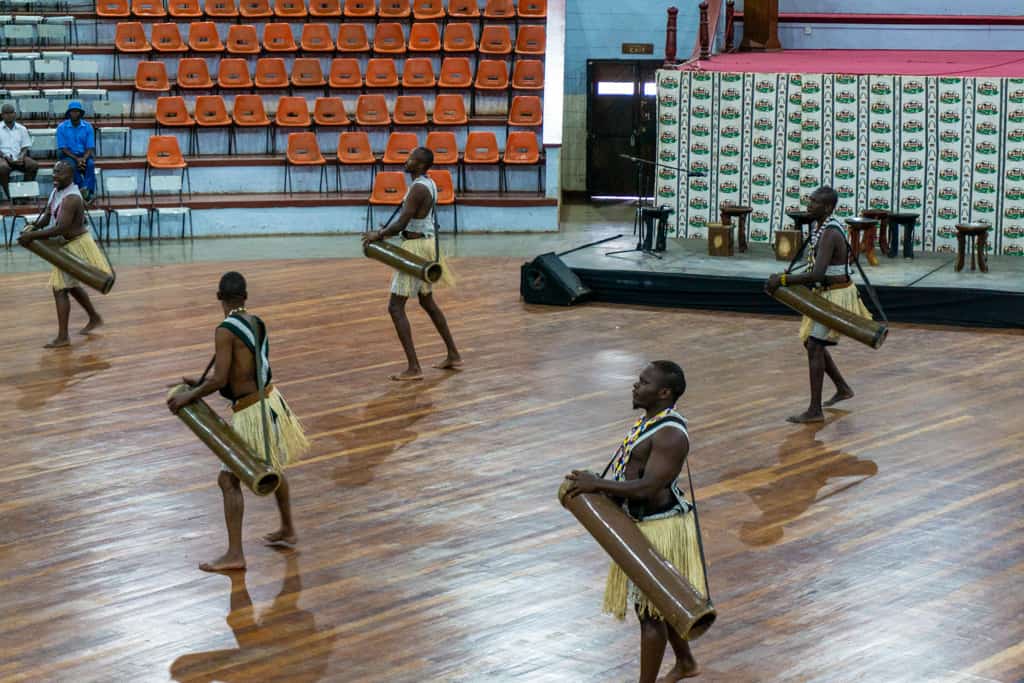
Most people visit Bomas of Kenya to see the daily dancing and drum performances. These start at 2:30 pm on weekdays and 3:30 pm on weekends, and last about 90 minutes. World-class dancers showcase a variety of costumes, music and dances from across the country — from the Swahili coast to the highlands around Mount Kenya.
The other highlight of the facility and one of the fun things to do in Nairobi is the enormous village museum. The property contains models of villages from more than 20 Kenyan tribes. They’re well-signed, with detailed descriptions explaining how the village architecture reflects and influences the social hierarchy and customs. If you’ll only have time to visit a Masaai community while in Kenya, Bomas is a must-visit to see the incredible diversity of this country.
One word of warning — Bomas is very much a tourist attraction (read: a little contrived). But it’s still well worth it, and when I visited, most of the other visitors were Kenyan.
Practicalities for visiting Bomas of Kenya
Price: 1,000 shillings per person. Discounts for East African residents and Kenyan citizens.
Opening hours: 9 am – 6 pm. Arrive 90 minutes before the dance performances to explore the museum first.
Facilities: The property is enormous, but the part open to tourists consists of just the museum and the auditorium. You’ll need to walk on uneven dirt paths to visit the museum. The only restrooms I could find were in the auditorium.
Location: Bomas of Kenya is in Langata, near the Galeria Mall.
How to get there: Bomas is near one of the biggest traffic junctions in the city. Every bus and matatu heading between the Central Business District/Westlands/Kibera and Karen/Langata stops at the enormous traffic circle near Galeria Mall. It’s a 5-minute walk or two-minute motorcycle taxi ride in a safe neighborhood on quiet streets. You could also Uber/taxi/take a tour, but traffic is pretty bad around Galeria.
Get the best view of Nairobi Kenya from the Kenyatta Conference Center
At street level, Nairobi is a pretty ugly city. Its concrete blocks won’t win any awards for architecture. But from above, you can really get a feel for its scale, greenery, and Rift Valley location. So one of the most fun things to do in Nairobi is to take the elevator up to the roof deck of the Kenyatta Conference Center for a 360-degree view of the city.
Key landmarks to look out for include Nairobi National Park, the leafy suburbs of Karen, the hills of the Rift Valley in the direction of Naivasha, and a truly epic sense of the traffic and congestion.
Even on a sunny day the view is a bit hazy from all the street-level pollution. So the ideal time to visit would be around 5:30 pm, when you can watch the sunset over East Africa’s only mega-city. This is one of the things to do in Nairobi you can’t miss!
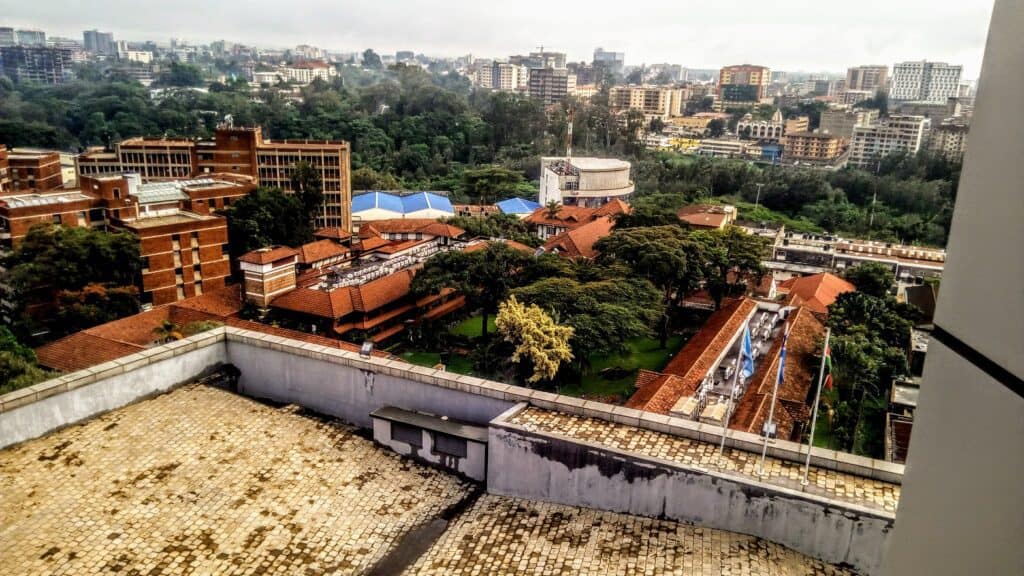
Practicalities for visiting the Kenyatta Conference Center
Price: 500 shillings per person. Discounts for East African residents and Kenyan citizens.
Opening hours: 7/8 am to 6 pm on weekdays/weekends. You will need to go through security, sign in, and leave your passport with the police.
Facilities: The conference center has restaurants, shops, and safari booking offices. But to visit the roof deck you will just pass through the lobby. Restrooms are available.
Location: The conference center is in the heart of the CBD. During daylight hours this is an easy and relatively safe walk from anywhere downtown. Take an Uber or taxi to your next destination if you come back down after dark. If you’re coming from Karen/Langata by public transport, take Bus 25. It will drop you east of Moi Ave in a dodgy and obscenely crowded area infamous for pickpockets and robberies, so you’re best off leaving your camera at your accommodation and snapping some photos on your phone.
Visit a Maasai market: fun things to do in Nairobi
If Kenya is famous for two things, it’s wildlife and the Maasai tribe. You’ve surely seen a documentary or two about them on the Discovery Channel. They’re famous for their colorful clothes, ear piercings, and nomadic way of life.
You’ll likely visit a Maasai community on your safari in Kenya. But if you won’t have time to travel beyond the capital, the best way to experience this culture is by visiting one of Nairobi’s Maasai markets. You’ll also get much better prices on souvenirs than in the bush. And it’s one of the most fun free things to do in Nairobi.
At a typical Maasai market, you’ll find everything from woven baskets to wood-carved giraffes to elaborate textiles to traditional drums and much, much more. The variety is pretty overwhelming — expect to wander around for a while before you buy.
Hassle factor can be high at the bigger markets, and bargaining is expected. Start by listening to others to get a feel for prices. Don’t enter a negotiation unless you’re serious about buying (although if the price is too high it’s okay to walk away). For me haggling at markets is one of my favorite things to do in Nairobi, I know that sounds silly, but it’s true! Vendors will virtually always throw in additional freebies if you buy a few things from them.

Bargaining at the Market
Kenyan bargaining culture is much friendlier and less aggressive than what you find in Asia. Keep a smile on, be friendly, chat a bit with the vendors, and ask for a good deal. But remember that the goal is not to find the lowest price you can possibly get away with paying, but rather to find a mutually acceptable price.
The biggest markets move around on a daily basis. Check out this article for current locations. If you’re okay with a smaller market, check out the one at Galeria Mall (if you’re facing the Java House, go to the left down a hallway and you’ll see it after 3 minutes walking — it’s outside the mall).
Practicalities for visiting a Maasai market
Price: Free to browse. Souvenirs run from 100 shillings through the roof, depending on what you buy.
Opening hours: Depends on the market, but usually 9 am to 5 pm. Markets are busiest in the morning.
Facilities: Depends on the market, but don’t expect much. Most markets are open-air.
Location: Varies depending on the day.
The best things to do in Nairobi for foodies: Eat at Carnivore or try Somali food
Ever wanted to try ostrich? How about camel?
Does eating your body weight in meat sound like a fun night out?
If so, you can’t miss Carnivore, Nairobi’s most iconic restaurant, and one of the best things to do in Nairobi for foodies!
Carnivore earned its place in travel legend about 20 years ago, when you could dine on exotic game meats like eland, zebra, and kob. A crackdown on poaching means it’s more traditional now (ostrich is the only true game meat available). But if you like meat, it’s still a pretty epic experience.
The way it works is you start by munching on salad and pumpkin soup. Then, waiters start to come by with huge trays of different meats. Pick what you want and dip it in the many sauce options. You can eat to your heart’s content — when you’re done, simply tip over the flag.
Many travelers consider Carnivore a worthy splurge and must-do when in Nairobi. But if you are on a backpacking budget, it’s likely out of your reach. No worries though — you can still have an incredible meat-heavy meal at Al Yusra. This Somali restaurant in the CBD has unique East African curries, grilled meats, and tasty biryanis. The juices are also superb. Better yet, you can walk out of here spending less than 500 shillings for a huge meal. And where else in the world are you going to try Somali food?
Practicalities for visiting Carnivore
Price: It’s a flat 4,000 shillings
Opening hours: Open for lunch or dinner — 11 am-11:30 pm. Reservations are essential: email reservations.carnivore@tamarind.co.ke.
Facilities: It’s a restaurant, so all the usual. The vibe is pretty high-end but they’re used to safari guests so you’re fine rolling up in dust-covered khakis.
Location: Near Wilson Airport. You can’t miss the huge sign for the turnoff. Any bus running from the center to Karen/Langata can drop you here, from where it’s a 1 km walk — but only walk during daylight hours. An Uber from the bus stop will run you about $5.
Get out in the bush right in the heart of Kenya’s capital: Safari in Nairobi National Park
Nairobi is the only city in Africa to have a national park right on its doorstep. This allows you the iconic photo opportunity of giraffes grazing with highways in the background, or watching a plane land directly over a feeding lion pride.
While Nairobi National Park isn’t anywhere near as magnificent as the Maasai Mara or Amboseli, you can easily do a half-day safari there for a fraction of the cost. And if you’re not planning on heading to the bush it’s the best place to see wildlife in urban Kenya.
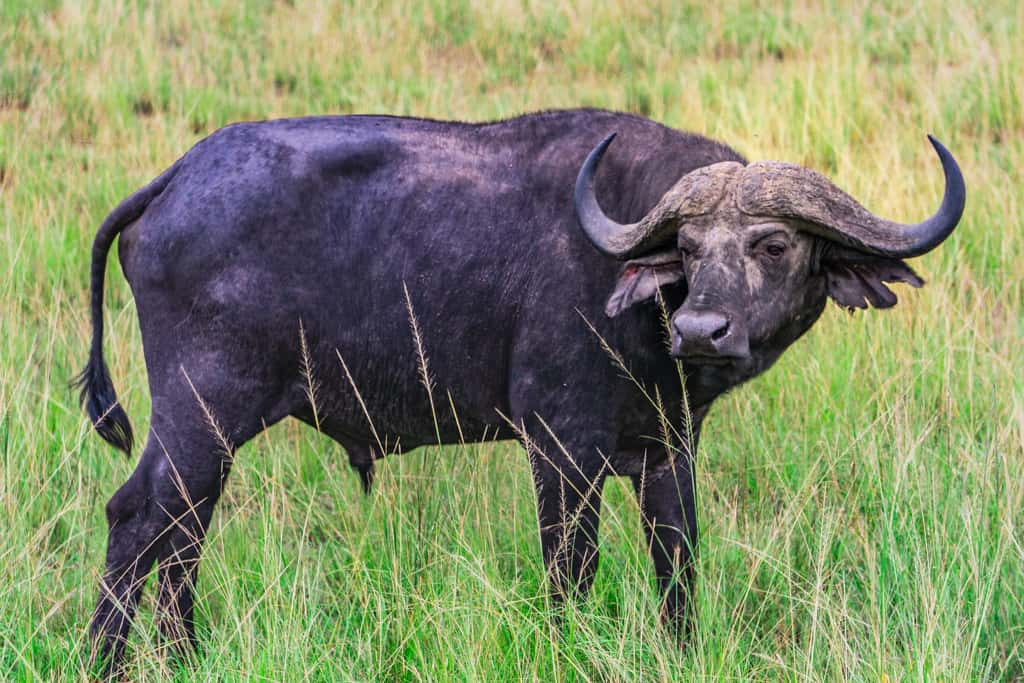
Game drives typically start at the crack of dawn and at 4 pm, but if you have your own wheels/driver you can enter the park throughout the day. A three-hour game drive is plenty to get a feel for the park.
You will almost certainly see buffalo, ostriches, elands, zebras, giraffes, and baboons. You have to be considerably luckier to find elephants or lions, and the cheetahs and leopards are extremely shy.
Practicalities for visiting Nairobi National Park
Price: Park entry fee is $43. A half-day safari through a tour company runs about $60.
Opening hours: Arrive by 7 am for a morning game drive, or at 4 pm for an afternoon game drive. There isn’t much point in visiting mid-day, as the wildlife won’t be very active.
Facilities: The park has a picnic area and a handful of restrooms.
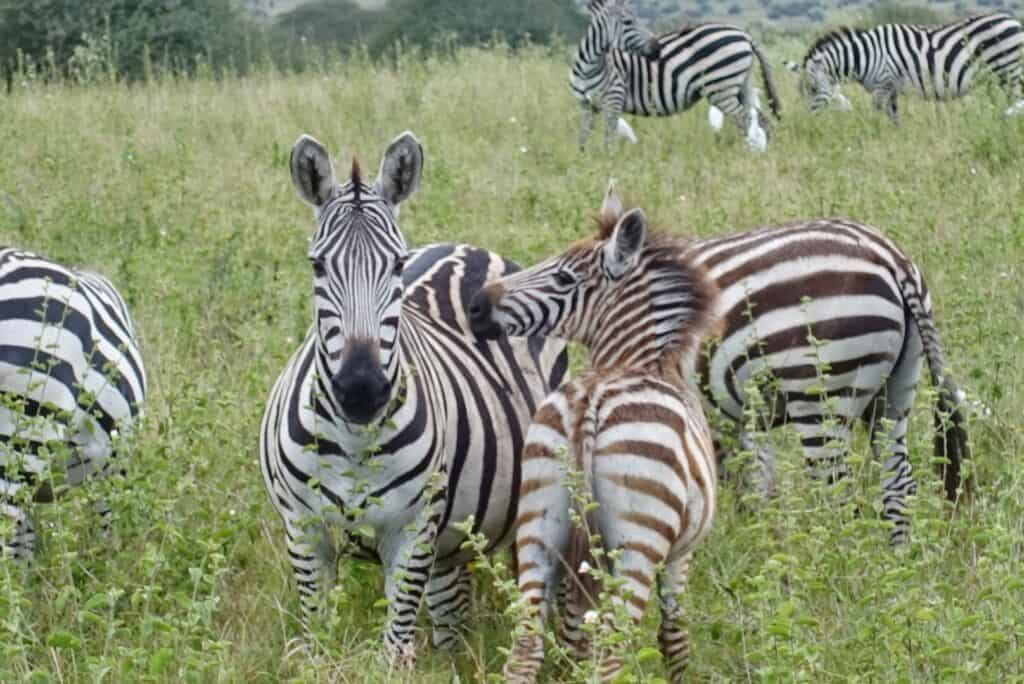
Location: The entrance for the park is in Karen. Most travelers visit with a private driver, but if you’re very determined and visiting Nairobi on a weekend, you can do it independently. Pick up the park shuttle from Moi Ave between 10 am and 12 pm for transport to the park. There, you’ll hop on a tour bus for a 1 pm game drive (along with about 60 Kenyan tourists). Talk to the staff at Milimani Backpackers to arrange a driver and save yourself some hassle.
Where to stay: For a truly spectacular safari in Nairobi National Park stay at The Emakoko Lodge, especially if you won’t be going on another safari in Kenya.
Visit the Kenya National Museum: The best activities to do in nairobi
The Kenya National Museum is the ideal starting point to learn about the natural and cultural history of the country. It’s one of the best Nairobi activities for culture vultures.
The permanent collection includes displays on poaching and wildlife conservation. It also devotes space to teaching you about the many different ethnic groups of Kenya, both historically and in the present day.
Additionally, the museum always houses a couple of special exhibitions, usually with an art/cultural focus. And the gardens on the grounds are the perfect place to escape the hectic Central Business District.
You need about two hours to rush through, or three hours to explore at a leisurely pace.
Practicalities for visiting the Kenya National Museum
Price: 1,200 shillings
Opening hours: 8:30 am-5:30 pm
Facilities: They have a lovely little cafe on site, as well as clean restrooms. The gift shop sells the usual tourist stuff, most of which is a step up in quality from what you find on the street.
Location: You can walk here from the CBD. I walked on a Sunday and it was creepily deserted — so if you’re alone, take an Uber for peace of mind. It’ll run you about $3. Bonus tip: There’s a Java House on the far north end of the CBD — get an Uber from here to save money since it’s a safe walk back to the center.
Learn about Karen Blixen’s life in Nairobi at the Karen Blixen House Museum
You probably know Karen Blixen from Out of Africa. If not, the short story is she is one of East Africa’s most famous colonial icons. Although what she’s famous for is still largely unclear to me. (The Kim Kardashian of the early-1900’s?)
Anyway, Blixen lived the good life as a White woman in Nairobi for a good 20 years. Her former home showcases her life and the way her namesake suburb, Karen, built up around her.
On the grounds of the museum you can also visit a botanical garden and one of Nairobi’s best cafes. It’s also right next door to Souk — the best place to pick up high-end crafts in Kenya. The whole experience makes for a lovely afternoon of exploring, eating, and shopping, but prepare for a hefty price tag.
Practicalities for visiting the Karen Blixen Museum
Price: 1,200 shillings
Opening hours: 8:30 am-6 pm
Facilities: Clean restrooms, a pricey cafe (budget $15 for lunch here), and shops.
Location: Right in the middle of Karen. From the CBD, take matatu 24. If you’re staying in Karen you could walk from Langata Road — it’s about 2 km and totally safe during daylight hours. An Uber runs about $3 from Bomas.
Discover a traveler legend in Nairobi: Have coffee at the Thorn Tree Cafe
It’s the cafe that gave the Lonely Planet forum its name. Where overlanders in Africa have posted essential travel tips for over a generation. Every bit as essential to the backpacking world as Khao San Road in Bangkok. The Thorn Tree Cafe is a must-visit for any hardcore travel enthusiast.
The cafe in the Stanley Hotel got its name from the acacia tree in the leafy courtyard. But it’s famous because in the center of the room is a bulletin board. In the “old days,” this was the only source of information about travel in East Africa — backpackers would write notes about bus routes, road conditions, good places to camp, and where to stock up on food.
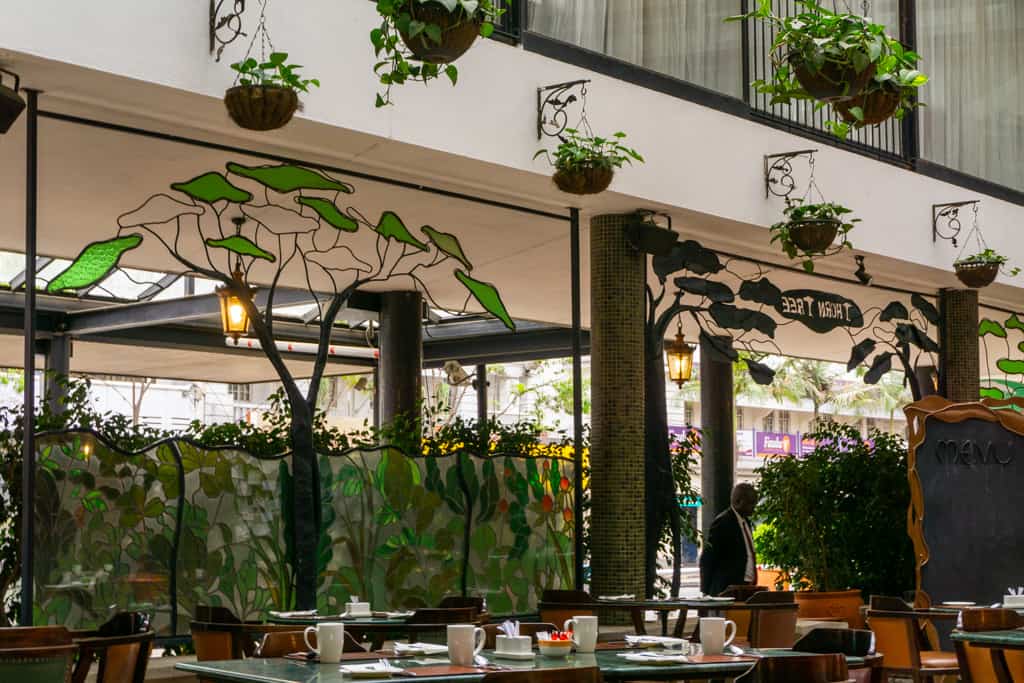
Today the bulletin board looks a bit bare, and you can find all the same information on the internet. But the atmosphere hasn’t changed.
Grab a table in the bright, green courtyard on a warm and sunny Nairobi morning. Sip a coffee, read the newspaper, and watch the hordes of 60-something tourists try to prep for their safaris. There’s nothing quite like it.
Practicalities for visiting the Thorn Tree Cafe
Price: Legend doesn’t come cheap. I only ordered a coffee and it still ran me 500 shillings.
Opening hours: 6 am-9:30 pm
Facilities: It’s inside the Stanley Hotel — note you’ll need to show ID and put your bags through a security screening.
Location: Right in the heart of the CBD — you can walk here from anywhere downtown during daylight hours.
Staying safe while exploring these fun things to do in Nairobi: Real talk
Okay y’all, I’ll admit, Nairobi did not make the best first impression on me. I arrived at the crack of dawn on a Sunday in the River Road area. My phone wouldn’t work (so I couldn’t call an Uber), I didn’t have money for a cab driver, and I had to endure an absolutely terrifying walk with all my belongings through the downtown area’s dodgiest neighborhood. The city has earned the nickname “Nai-Robbery” for a reason.
But — here’s the thing. If you stay west of Moi Ave, north of the train station, and east of Kenyatta Ave in the Central Business District, central Nairobi is very safe during the day. In fact, there are so many security guards on street corners that you’ll likely feel a bit over-policed.
I walked around the CBD alone on a Sunday (the quietest day) and a Monday. Yes it was crowded on the weekday, and I could see how someone clever could pickpocket you if you’re not careful. But I never felt remotely unsafe in the CBD during the day.
Additionally, the suburbs of Westlands, Karen and Langata are very safe day and night. You can generally walk to a restaurant in Karen for dinner and then hit a bar before walking back to your hotel without a worry. I walked alone from Galeria Mall to Milimani Backpackers at 8 pm with no problems.
Tips to Follow for Staying Safe
Follow a few easy rules and you’ll be at very little risk in Nairobi:
- In the CBD, get off the streets at 5 pm. After 5 pm, you should always take a cab or Uber door-to-door. Even if you’re going two blocks. Any hotel, restaurant or bar can call a cab for you.
- Stay away from Uhuru Park after dark.
- The bus stations and matatus are all in the dodgy River Road area. Keep a very close eye on your belongings here and take a cab if you can, day and night. In addition to the plethora of dodgy characters, the crowds here mean pickpocketing is a big risk.
- Kibera is where most crime in Nairobi happens. Buses from the CBD to Karen pass through Kibera. Keep an extra-close eye on valuables when riding these buses, as they’re crowded and pickpocketing is common.
- It’s probably not the best idea to carry a camera around downtown Nairobi under any circumstances. Phones are fine, but leave the zoom lens in your hotel room.
- Nairobi is a city where it’s worth choosing a hotel/hostel/campsite with extra security.
- If you have a car in Nairobi, always lock the doors. Many drivers roll through red lights at quiet intersections at night to prevent car-jacking.
How to get to and around Nairobi, Kenya
Nairobi is one of the biggest gateways to East Africa. So getting here is a breeze.
Most international flights arrive at Kenyatta International Airport. It’s about an hour outside the city center — but if heading to the airport, allow at least two hours due to traffic. Kenyatta is a very modern airport with all the usual amenities. You can grab a cab from Arrivals or arrange a hotel pickup for around $30. You can also take a public bus, but it’s widely considered a bad idea — robberies are alarmingly common on this route.
If you’re flying to Nairobi from elsewhere in Africa, you may arrive at Wilson Airport instead. This tiny airport is weirdly spread-out, and it’s harder to find a cab here. Your best option is to arrange hotel pickup (around $15 from Karen/Langata or $20 from the CBD). Alternatively, walk out to the main road and hop on Bus 25, which passes the airport between Langata and the CBD. Only take the bus during daylight hours, but it’s safe.
Arriving by bus or matatu, try to make sure you have data on your phone. You’ll arrive in the dodgy River Road area east of the CBD and you’ll want to call an Uber right away. It costs about $10 to Karen/Langata, $5-7 to Westlands or $3-ish to anywhere downtown. If you can avoid taking an Easy Coach bus into Nairobi, do avoid it — the Easy Coach station is in the worst part of this bad neighborhood.
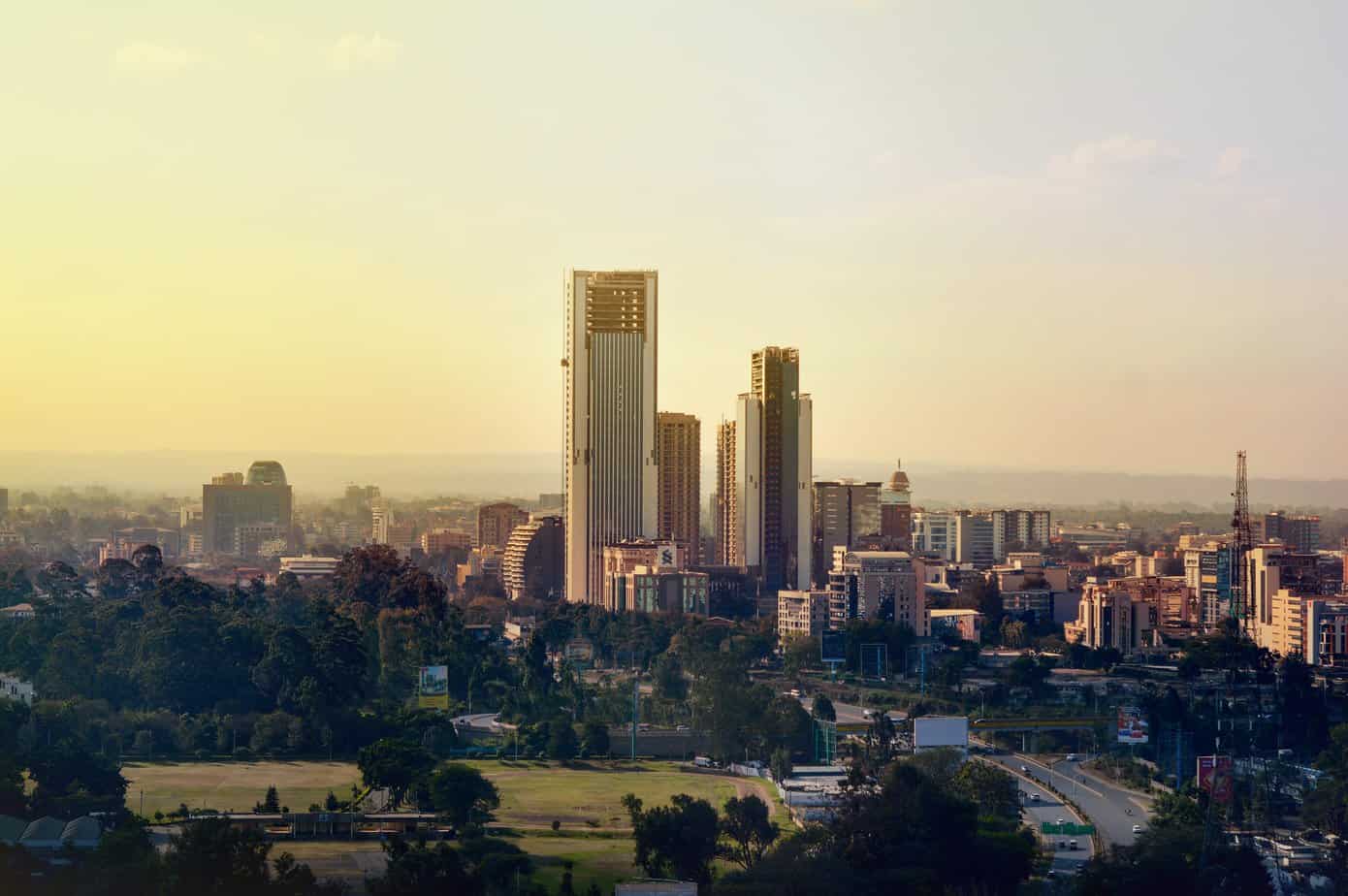
Getting around
When it comes to getting around Nairobi, the biggest factor is the abominable traffic. Distances that look ten minutes away on a map can take an hour and a half in a car. Don’t even think about heading to or from the CBD during rush hour on a weekday, unless you have endless patience. (Rush hour lasts from around 7:30 am-10 am and 4:30 pm-7 pm.)
Most people get around Nairobi by hiring a driver. This costs about $50 for the day, which is well worth it if you’re in a group of four or more. But if you’re on your own, you’ll save tons of money by taking the matatus and public buses.
The matatus (minibuses) seem intimidating at first, but they’re actually quite simple. Routes have numbers (which are never displayed) and the drivers are genuinely helpful. You pay a fixed fare (I was never overcharged and the fares were clearly posted in every vehicle so I could check) — around 100 shillings off-peak, or 250 shillings during peak hours, but it varies by distance. You hop off at any stop along the way.
Useful bus and matatu routes are Route 25 between Langata and the CBD, any matatu running along Langata Road to Bomas, and any matatu running along South Langata Road from the junction. You’ll never wait more than 10 minutes for a vehicle here and they can get you close to the Giraffe Center, Karen Blixen Museum, Elephant Orphanage, and other top Nairobi attractions.
Where to stay: The best budget hotel in Nairobi
Despite everything else being pricey in Nairobi, the city has a fantastic budget accommodation option — Wildebeest Eco Camp. This place is bush-meets-capital-city — it’s in a quiet garden off Langata Road, about a mile from Galeria Mall. You won’t hear any traffic noise. It has a pool, very clean restrooms, and a fantastic restaurant (definitely splurge on the buffet dinner).
Rooms range from $12 to pitch your own tent to mid-range luxury permanent tents, with everything in between. Breakfast is included — you can order something fresh-cooked off the large menu.
Plus, Wildebeest Eco Camp is wonderfully social. Dinner is family-style at big group tables. You’ll share your meal with fellow travelers and guides who can give you local tips.
Wildebeest Eco Camp is a ten-minute walk down a quiet road from the nearest bus stop. It’s safe to walk in this area during daylight hours. You can leave your valuables locked up at reception when you’re out and about.
A few final/random tips about Nairobi:
- Nairobi has about the most perfect weather of anywhere in the world. It’s 80 degrees and sunny year-round, with temperatures dropping into the 60’s at night. In rainy season you’ll get afternoon/evening downpours.
- I found Nairobi to be just about the friendliest capital city I’ve ever visited. People actually like talking to strangers here. Yes, there are some safari touts and con men, but for the most part the friendliness is genuine.
- Java House is the place to go for good coffee on a budget.
- Speaking of budgets, Nairobi is a surprisingly expensive city. Most things cost about the same as they would in the U.S. or Europe.
- If you’re on limited time, or if it’s your first trip to Africa and you want to get acclimated before exploring on your own, you can take a city tour to hit up most of these attractions.
Love my activities to do in Nairobi post? Pin it!

